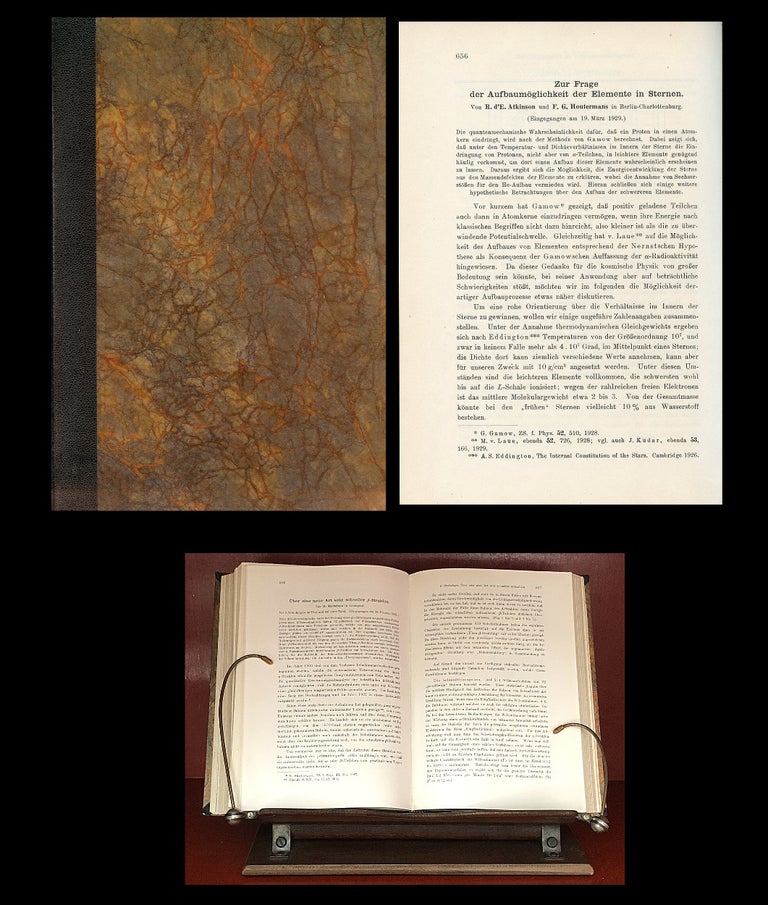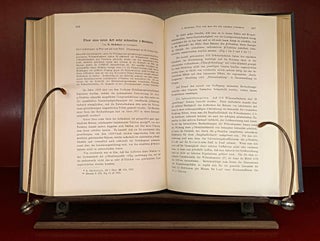Zur Frage der Aufbaumoglichkeit der Elemente in Sternen (Atkinson & Houtermans, pp. 656-665) WITH Uber eine neue Art sehr schneller -Strahlen (Skobelzyn, pp. 686-702) in Zeitschrift für Physik, vol. 54, 1929
Berlin: Julius Springer, 1929. 1st Edition. Full volume, bound, including TWO IMPORTANT 1st EDITIONS: Atkinson & Houtermans’ SEMINAL PAPER CONCLUDING THAT QUANTUM TUNNELING MAY ALLOW FOR THE GENERATION OF ENERGY IN STARS THROUGH NUCLEAR FUSION. In this, the 1st attempt to apply the Gamow factor to explore fusion reactions in stars, Atkinson and Houtermans present the first calculation of stellar thermonuclear reactions. WITHBOUND: Skobelzyn’s DISCOVERY OF GHOSTLY TRACKS MADE BY COSMIC RAYS IN A CLOUD CHAMBER, a device for revealing the passage of charged particles. While trying to detect gamma radiation in cosmic rays, Skobelzyn had “detected particles that acted like electrons but curved in the opposite direction in an applied magnetic field. He was puzzled by these results, and they remained unexplained until the discovery of the positron in 1931” (Wikipedia). More information on both papers follows below.
ATKINSON & HOUTERMANS PAPER: "The Houterman-Atkinson theory was a quantitative theory based on the most recent quantum mechanical knowledge. The theory counts among the pioneering contributions to modern astrophysics, but at first it attracted little attention" (Kragh, 183).
“Results from early nuclear physics research, in particular the discovery of the enormous energy stored in nuclei, led astrophysicists to suspect that reactions among nuclear species were the source of the energy in stars. This suspicion, coupled with the discovery of the tunneling effect by Gamow (1928) prompted Atkinson and Houtermans to [here] produce the first qualitative theoretical treatment of the problem.
“Their paper, in which they referred to ‘how to cook a nucleus in a pot,’ treated the energy source in stars as well as the stellar nucleosynthesis of the elements. With the nuclear data available to them, they concluded that only hydrogen could penetrate the Coulomb barrier with sufficient ease to induce fusion at stellar temperatures, and that hydrogen-induced fusion would be important only for light nuclei. Because it was known that hydrogen is the most abundant element in the Sun and the universe, they concluded that the energy-producing mechanisms involved primarily hydrogen.
“Atkinson and Houtermans suggested that the nucleus acts as a sort of trap and cooking pot combined, catching four protons and two electrons in such a way that a helium nucleus is finally cooked with the release of a large amount of energy” (Barnes, Essays, 171). “The thermal energy of protons in the centre of the sun was sufficient to provoke nuclear reactions. The physical possibility of thermonuclear reaction in the interior of stars was established." (Brandt, Harvest, 259).
SKOBELZYN’S PAPER: “In 1929, [Skobelzyn] constructed a cloud chamber to study the properties of the electrons emitted in radioactive decays” (Skobelzyn, 1929; Longair, 28). “A determination of the specific ionization of cosmic-ray particles, first, by a count of the number of drops per cm along cosmic-ray tracks on cloud-chamber photographs and, second, by measurements of the energy loss in lead has shown that the great bulk of the cosmic-ray particles of positive charge are positive electrons” (Anderson, PR 44, 406).
Among the tracks, he noted some which were hardly deflected at all and which resembled electrons with energies greater than 15 MeV. Skobelzyn had discovered that cosmic rays create large particle showers indicating that at least some of the primary cosmic rays must have enormous stores of energy. These were the first pictures of the tracks of cosmic rays. Item #1130
CONDITION & DETAILS: Complete. 4to Bears ffp stamp of Friedrich Hermann Hund, a physicist well-known for his work on atoms and molecules. The volume is ex-libris with very slight ‘ghosting’ from the removal of spine labels. Small stamp appears on the rear of the title page. Bound in black cloth over marbled paper board; gilt-lettered at the spine. Very slightly rubbed at the edges. Tightly bound and very clean. The interior is clean and bright. Very good +.
Price: $400.00



